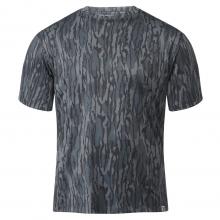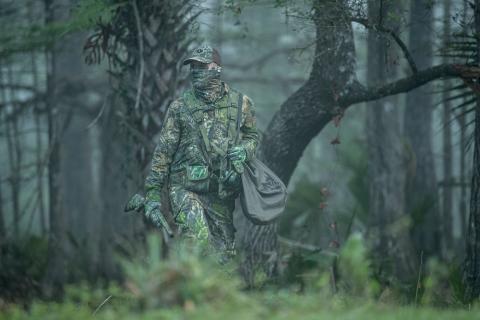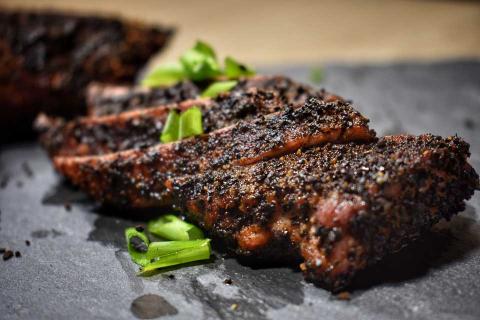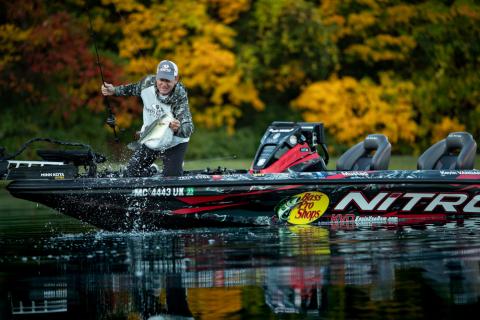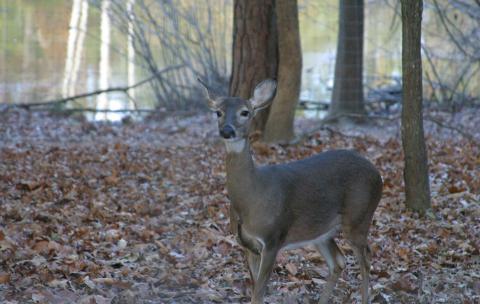With Bonus Trout Recipes
Brad Fenson
Lake Trout (Salvelinus namaycush)
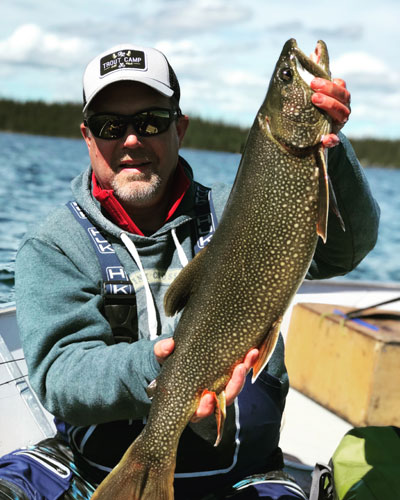 Despite its name, lake trout are not actually true trout but are considered char within the Salmonidae family, with the Arctic char as its closest relative. A char by any other name is still a char, but other names include mackinaw, lake char, grey trout, and togue. To confuse matters more, lakers are trout-like in appearance with elongated bodies and a deeply forked tail. They have a stocky head, large mouth, and are broad across the back.
Despite its name, lake trout are not actually true trout but are considered char within the Salmonidae family, with the Arctic char as its closest relative. A char by any other name is still a char, but other names include mackinaw, lake char, grey trout, and togue. To confuse matters more, lakers are trout-like in appearance with elongated bodies and a deeply forked tail. They have a stocky head, large mouth, and are broad across the back.
Lake trout colorations vary from a dark green to gray or olive brown background that is darker on top and fades to silvery on the sides and lighter pale yellow or white near the belly. Irregular shaped cream or pale-yellow spots cover their entire bodies from head to tail, which helps distinguish them from their char cousins whose spots are more orange, pink or red.
How big do they get?
Male and female lake trout are similar in appearance and size, with males having a slightly longer and more pointed snout. Lake trout vary widely in size and weight and are commonly found around the 19-inch mark but can reach lengths of over 48 inches. According to the International Game Fish Association, the world record lake trout caught on rod and reel is 72 pounds in 1995 on Great Bear Lake in the Northwest Territories. The largest laker ever netted was in 1961 from Lake Athabasca in Alberta and weighed a whopping 102 pounds.
Where are lake trout found?
These freshwater fish live in cold, oxygen-rich deep lakes throughout northern Canada, including some Arctic islands, Alaska, and even to the northeastern United States and the Great Lakes. They are non-migratory but live at various depths within the same waterbody depending on the season. In the summer, they occupy the cooler waters of the pelagic zone near the bottom of the lake, at depths up to 200 feet, and will move upward to more shallow waters in the spring and fall. Lake trout feed primarily on other fish like whitefish, burbot and sculpin, but will also feast on crustaceans, insects, plankton and even small mammals - the size of prey typically increases as the lake trout grows up.
Lake trout are a slow-growing fish, late to mature, with spawning beginning after age five and continuing usually only every second year after that. As such, populations are vulnerable to overfishing. Lake trout can occasionally live over 40 years.
Lake trout flesh is firm and delicate in flavour, and can range from a pale yellow, or cream color, to a bright orange or pink, depending on what they are feeding on. Lake trout flesh is very popular for its versatility, as it can be baked, grilled, fried, canned, or smoked.
When is the best time to catch them?
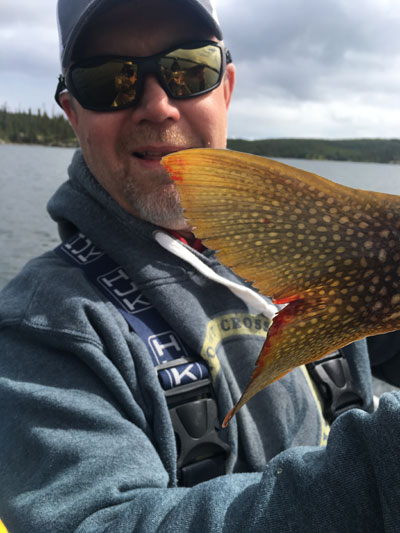 Finding lunker lakers is as easy as locating best habitat and knowing the seasonal patterns of these fish. Lakers are fall spawners and will congregate along rocky shorelines and shoals as water temperatures start to drop, making them easy to target in shallow water. In the spring, lake trout can be found in the shallows, dispersed in the productive feeding zone while water temperatures remain cold. Late spring the fish start to congregate in the deeper, colder basins of the lake and remain there until fall. I’ve found that fishing is generally best in June and into July and August when fish are concentrated in the deep-water basins and can easily be targeted. More daylight and warmer temperatures increase fish activity and time spent feeding, allowing anglers to find aggressive fish. The real key is looking for the best habitat in the basin, which will undoubtedly hold the bigger fish.
Finding lunker lakers is as easy as locating best habitat and knowing the seasonal patterns of these fish. Lakers are fall spawners and will congregate along rocky shorelines and shoals as water temperatures start to drop, making them easy to target in shallow water. In the spring, lake trout can be found in the shallows, dispersed in the productive feeding zone while water temperatures remain cold. Late spring the fish start to congregate in the deeper, colder basins of the lake and remain there until fall. I’ve found that fishing is generally best in June and into July and August when fish are concentrated in the deep-water basins and can easily be targeted. More daylight and warmer temperatures increase fish activity and time spent feeding, allowing anglers to find aggressive fish. The real key is looking for the best habitat in the basin, which will undoubtedly hold the bigger fish.
A small mid-lake hump, sunken island or gravel bar may look subtle on a map or depth sounder but is exactly what you should look for to locate above average fish. Flowing water should never be overlooked.
What is the best bait to catch them with?
Use crankbaits that closely resemble the baitfish, like whitefish, tullibee and cisco that trout target daily. The popular forage species have large, reflective scales and a tapered head and body that are imitated by the size and shape of several crankbaits. Keying in on color combinations and size of bait that lake trout are used to feeding on will give you the advantage to consistently catch more trout.
Spoons have been a long-time favorite of mine, as they provide great diversity and have all the flash and vibration required to trigger a strike. The different shapes, weights and concave of the spoons will vary drastically, and anglers need to try different presentations to find out what might be working best. A few of my personal favorites include a variety of lightweight flutter spoons with a fast action. Some of the spoons produced for salmon fishing double as awesome lake trout lures. Williams makes several lightweight spoons that can be fished fast, which generate powerful strikes. They are fished on sunny days when fish will be actively sight feeding.
What is good to know before/during/after you clean them?
Lake trout are best eaten fresh, as the high fat content breaks down when they are frozen and thawed. You can also can trout. The flesh is delicate, and fish being kept for the table should be stored in a cooler with ice. Lake trout can be filleted boneless or baked whole with the guts and gills removed.
Here are the three simple recipes to smoke trout, salmon, or other fish at home.
Wet Brine Smoked Trout
- ½ cup pickling salt
- ½ cup brown sugar
- 5-8 large garlic cloves, crushed
- 1 gallon cold water
1. Mix the salt and brown sugar into the water and stir until both ingredients are dissolved.
2. Add the trout and cover. Make sure all the fish is covered with brine. Store in the refrigerator - or in cases of larger batches, in an insulated cooler - for at least two hours, but overnight is best.
3. Remove the trout from the brine, rinse it and dry it by patting it with paper towel and letting it air dry to a sheen. Smoke the trout using your favorite smoking method.
Soy Sauce Brine
- 1 cup soy sauce
- ¼ cup brown sugar
- 2 Tbsp sriracha sauce
- 4 Tbsp fresh ginger (or 1 Tbsp ground ginger)
- 4 large garlic cloves, crushed
1. Combine all ingredients and stir until sugar is dissolved.
2. Place trout flesh side down in the brine. Store in the refrigerator - or in cases of larger batches, in an insulated cooler - for at least two hours, but overnight is best.
3. Remove the trout from the brine, dry it by patting it with paper towel and letting it air dry to a sheen. Smoke the trout using your favorite smoking method.
Dry Brine
- Your favorite seasoning salt and pepper, or your favorite spice blend
- 2 tsp ground ginger
- ¼ cup brown sugar
1. Sprinkle spices and sugar all over the flesh of the trout and rub it in to ensure all the flesh is covered.
2. Lay the filets flesh sides together and wrap together in plastic wrap or place in a bag. Store in the refrigerator - or in cases of larger batches, in an insulated cooler - for at least two hours, but overnight is best.
3. Open the filets and let air dry to a sheen. Smoke the trout using your favorite smoking method.

Need wild game meat for a recipe you've been wanting to try? Check out GameKeeper Butchery. GameKeeper Butchery is dedicated to procuring the finest assortment and highest quality of specialty meats from the United States and around the world. Our commitment is to deliver the safest, freshest and most wholesome products.






